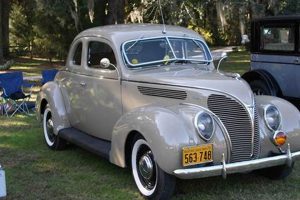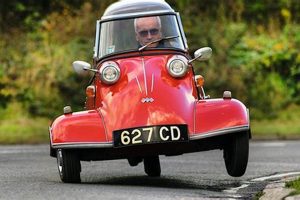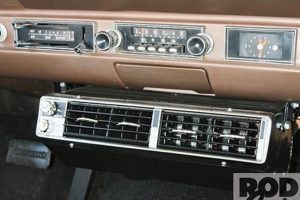Classic automobiles originating from the United Kingdom represent a significant part of automotive history. These vehicles, typically manufactured several decades ago, embody distinctive design elements and engineering philosophies prevalent during their respective eras. Examples include models from manufacturers such as MG, Jaguar, and Austin-Healey.
These automobiles hold considerable cultural and economic value. They serve as tangible links to the past, reflecting the technological advancements and societal trends of their time. Furthermore, the restoration and preservation of these vehicles contribute to a specialized automotive industry, generating economic activity and preserving valuable skills. The historical context of these machines often provides insight into the development of the automotive industry as a whole.
The following sections will delve into specific aspects, including identifying characteristics, prominent marques, and the burgeoning market that surrounds their acquisition and maintenance. Furthermore, the enduring appeal and the challenges associated with owning and restoring these classics will be examined.
Considerations for Acquiring and Maintaining Classic UK Automobiles
The acquisition and upkeep of classic automobiles from the United Kingdom requires careful planning and execution. The following are crucial points for prospective owners and enthusiasts.
Tip 1: Thoroughly Inspect Prior to Purchase: A pre-purchase inspection by a qualified mechanic specializing in classic British vehicles is essential. This inspection should assess the engine, transmission, chassis, and bodywork for signs of wear, damage, or previous repairs. Documented maintenance history, if available, provides valuable insights.
Tip 2: Verify Authenticity and Provenance: Investigate the vehicle’s origins and confirm its specifications match factory records. Matching numbers (engine, chassis, and body) are important for verifying originality and can significantly affect value. Contact marque-specific clubs or historical societies for assistance.
Tip 3: Source Genuine or High-Quality Replacement Parts: Due to the age of these vehicles, replacement parts may be difficult to source. Prioritize genuine parts when available, or opt for high-quality reproductions from reputable suppliers. Inferior components can compromise reliability and authenticity.
Tip 4: Implement a Regular Maintenance Schedule: Adhere to a strict maintenance schedule, including regular oil changes, lubrication of chassis components, and inspection of critical systems. Classic British cars often require more frequent maintenance than modern vehicles. Consult a workshop manual for specific requirements.
Tip 5: Protect from the Elements: Exposure to moisture, sunlight, and extreme temperatures can accelerate deterioration. Store the vehicle in a dry, well-ventilated garage or use a high-quality car cover when not in use.
Tip 6: Engage with the Community: Joining a marque-specific club or online forum provides access to a wealth of knowledge and support. Experienced owners can offer valuable advice on maintenance, repair, and sourcing parts.
Tip 7: Understand the Unique Driving Characteristics: Classic British cars often exhibit different driving characteristics compared to modern vehicles. Familiarize oneself with the vehicle’s handling, braking, and engine performance to ensure safe and enjoyable operation.
Careful attention to these areas will not only improve the longevity and value of the classic automobile but also enhance the ownership experience. Understanding the specific nuances of maintaining these vehicles is essential for their preservation.
The subsequent discussion will address the ongoing preservation efforts and the future outlook for these historically significant automobiles.
1. Iconic Design
The “Iconic Design” found in numerous collectible British automobiles is a primary driver of their enduring appeal and high valuation. This aesthetic, born from specific historical and cultural contexts, distinguishes these vehicles from their contemporaries. The effect of “Iconic Design” extends beyond mere visual appeal; it embodies the spirit of an era, reflecting the aspirations and technological capabilities of the time. Examples include the flowing lines of the Jaguar E-Type, the utilitarian charm of the Land Rover Series I, and the compact ingenuity of the original Mini. The importance of this design is paramount; it is integral to understanding the vehicle’s historical context and its value as a piece of automotive art.
Further analysis reveals how engineering and design collaborated to create memorable forms. The MG TC, for instance, translated pre-war sports car aesthetics to a post-war audience, establishing a recognizable British roadster style. The practical application of understanding “Iconic Design” lies in the restoration and preservation efforts undertaken by enthusiasts. Accurate restoration requires a deep appreciation for the original design intent, ensuring that replacement parts and modifications remain faithful to the vehicle’s initial character. It influences car selection and how car is modified to make it unique.
In summary, the “Iconic Design” element is a key determinant in the desirability and value of British classic cars. This facet links the vehicle to its historical roots and informs the efforts to preserve these automotive treasures. The challenge lies in maintaining the authenticity of the design while adapting to modern needs and regulations. Ultimately, the appreciation of “Iconic Design” ensures that these vehicles remain relevant and celebrated for generations to come.
2. Engineering Innovation
Collectible British automobiles are not merely artifacts of design; they represent significant advancements in automotive engineering. Examination of these vehicles reveals innovative solutions to the challenges of their respective eras, influencing subsequent automotive development and setting benchmarks for performance and efficiency.
- Transverse Engine Layout and Front-Wheel Drive
The Mini, designed by Alec Issigonis, revolutionized small car design with its transverse engine layout and front-wheel drive configuration. This arrangement maximized interior space within a compact footprint, a concept that became widely adopted by other manufacturers and remains a staple of modern small car design. Its impact resonated far beyond British shores, influencing global automotive trends.
- Independent Suspension Systems
British marques such as Jaguar pioneered the use of independent suspension systems to improve ride quality and handling. The Jaguar XK120, for example, featured independent front suspension, contributing to its superior road holding and driver comfort compared to many contemporary vehicles. The implementation of such systems demonstrated a commitment to engineering excellence and driving dynamics.
- Disc Brake Technology
The widespread adoption of disc brakes began with British manufacturers. The Jaguar C-Type racing car was one of the first to utilize disc brakes effectively, demonstrating their superior stopping power and resistance to fade compared to drum brakes. This innovation quickly migrated to road cars, enhancing safety and performance across the automotive industry.
- Unitary Body Construction
The Morris Minor was among the first mass-produced British cars to employ unitary body construction, where the body and chassis are integrated into a single structure. This design increased structural rigidity, reduced weight, and improved overall safety compared to traditional body-on-frame construction. Its adoption marked a significant shift in automotive manufacturing practices.
These examples of “Engineering Innovation” embedded within “vintage british cars” highlight the significant contributions of British automotive engineers to the global automotive landscape. These advancements continue to inspire and influence modern automotive design, showcasing the lasting impact of these vehicles beyond their aesthetic appeal and historical significance. The careful study and preservation of these innovations are crucial for understanding the evolution of automotive technology.
3. Cultural Significance
The cultural impact of classic British automobiles extends beyond mere transportation; these vehicles often serve as tangible embodiments of national identity, historical periods, and societal values. The presence of British marques in popular culture, from film and television to literature and music, has cemented their status as cultural icons. The association of specific models with particular social groups or historical events further enhances their cultural importance. For example, the Mini, with its compact size and innovative design, became synonymous with the youthful, rebellious spirit of the 1960s. The Land Rover, known for its ruggedness and go-anywhere capability, is closely linked to exploration and adventure, reinforcing a perception of British ingenuity and resilience.
The preservation and restoration of these automobiles contribute to the maintenance of cultural heritage. Car clubs and enthusiasts dedicate significant resources to preserving these vehicles, ensuring that future generations can appreciate their historical and artistic value. Rallies and shows featuring these automobiles provide opportunities for communities to come together and celebrate automotive history, fostering a sense of shared identity and cultural pride. Understanding this “Cultural Significance” is vital for appreciating the full scope of these vehicles beyond their mechanical function and monetary value. This understanding informs preservation efforts, impacting restoration philosophies and influencing the valuation placed on authenticity and originality.
The challenge lies in balancing the preservation of cultural heritage with the practical needs of modern society. Striking a balance between historical accuracy and contemporary usability requires careful consideration. Ultimately, the recognition of cultural significance ensures that these vehicles are valued not only as machines but also as important artifacts that reflect the evolution of British society and its global influence. Their continued presence on roads and in museums serves as a reminder of the ingenuity, style, and cultural impact that have shaped the automotive world.
4. Rarity and Condition
The confluence of rarity and condition is a primary determinant in the valuation and desirability of collectible automobiles from the United Kingdom. The limited production numbers of certain models, coupled with the preservation of their original state, significantly amplifies their appeal among collectors and enthusiasts. These intertwined aspects directly influence market dynamics and restoration priorities.
- Original Production Volume
The initial quantity of a particular model directly affects its current rarity. Models produced in limited numbers, either due to design complexity, specialized manufacturing processes, or limited market demand at the time, inherently possess greater scarcity value. The Jensen Interceptor, for example, featured hand-built elements, restricting production and enhancing its collectibility today. The lower the number of examples originally manufactured, the higher the potential value, assuming comparable condition to other vehicles.
- Survival Rate
The attrition rate of classic vehicles over time further impacts rarity. Accidents, neglect, and the challenges of maintaining aging automobiles reduce the number of surviving examples. Models known for mechanical fragility or susceptibility to rust often have lower survival rates, increasing the value of those that remain in good condition. The Triumph TR6, while popular, is prone to rust issues, making well-preserved examples increasingly sought after.
- Originality and Authenticity
The degree to which a vehicle retains its original components and specifications significantly impacts its value. Automobiles with matching numbers (original engine, chassis, and body) and minimal modifications are generally considered more desirable. Deviations from factory specifications, while sometimes unavoidable during restoration, can detract from the vehicle’s authenticity and, consequently, its value. A Jaguar XK120 retaining its original engine and interior trim would command a higher price than one with non-original components.
- State of Preservation
The overall condition of a vehicle, encompassing its mechanical functionality, cosmetic appearance, and structural integrity, plays a crucial role in determining its worth. Well-maintained examples with documented service histories and minimal signs of wear or damage command premium prices. Vehicles that have undergone professional restoration to concours standards often represent the pinnacle of collectibility. A meticulously restored Aston Martin DB5, with every component refurbished to original specifications, exemplifies the influence of condition on value.
These factors, when assessed collectively, provide a comprehensive understanding of the relationship between rarity, condition, and the value of “vintage british cars.” The interplay of limited original production, low survival rates, retained originality, and impeccable preservation elevates these automobiles to sought-after collectibles, commanding significant premiums in the classic car market. Accurate assessment of these attributes requires expert knowledge and careful scrutiny.
5. Market Value
The market value of collectible automobiles originating from the United Kingdom is a dynamic and complex metric, influenced by a confluence of factors. Understanding these influences is crucial for collectors, investors, and enthusiasts seeking to navigate this specialized segment of the automotive market. This section will examine key facets that contribute to the valuation of these vehicles.
- Historical Significance and Provenance
A vehicle’s documented history, including its original ownership, racing pedigree, or involvement in significant historical events, can substantially enhance its market value. Examples include automobiles with verifiable ties to notable figures or those that participated in prestigious motor races. A well-documented Aston Martin DB4 previously owned by a prominent individual would likely command a premium compared to a similar model with an unknown history. The ability to trace a vehicle’s lineage adds a layer of intrinsic value, appealing to collectors seeking more than just mechanical merit.
- Scarcity and Availability
The number of examples of a particular model remaining in existence significantly affects its market value. Limited production runs or low survival rates due to attrition from accidents, neglect, or lack of maintenance contribute to scarcity. For example, the Jaguar XKSS, a road-going version of the D-Type racing car, was produced in extremely limited numbers, making it one of the most valuable British automobiles. The principle of supply and demand dictates that scarce items command higher prices, assuming consistent demand.
- Condition and Restoration Quality
The overall condition of a vehicle, encompassing its mechanical functionality, cosmetic appearance, and structural integrity, is a primary determinant of its market value. Professionally restored vehicles that adhere closely to original factory specifications often command the highest prices. A concours-quality restoration, where every component is meticulously refurbished or replaced with authentic parts, represents the gold standard in preservation. The meticulousness and accuracy of a restoration directly correlate with the vehicle’s assessed market value.
- Market Trends and Collector Demand
Prevailing market trends and collector preferences exert considerable influence on the valuation of classic British automobiles. Shifts in collector tastes, economic conditions, and the emergence of new collector demographics can drive demand for specific models or marques. For instance, a renewed interest in pre-war British sports cars could lead to an increase in the market value of models such as the MG TC or the Austin Seven. Monitoring market trends and understanding collector preferences is essential for making informed investment decisions.
These multifaceted elements collectively shape the dynamic market value landscape for classic British automobiles. Accurate assessment requires detailed knowledge of historical records, meticulous inspection of vehicle condition, and an awareness of current market trends. The interaction of these influences creates a complex equation that ultimately determines the price commanded by these vehicles in the collector car market. Appreciation is also key to have this market value in British cars.
Frequently Asked Questions
The following section addresses commonly encountered queries regarding classic automobiles originating from the United Kingdom. The responses aim to provide clarity and dispel potential misconceptions within this specialized automotive domain.
Question 1: What constitutes a “vintage” British car?
Generally, a British automobile manufactured prior to 1980 is often categorized as “vintage.” However, this definition can vary depending on the specific context and the criteria employed by automotive clubs, historical societies, and insurance providers. The term “classic” is also frequently used and may overlap or supersede the “vintage” designation depending on factors like production numbers and historical importance.
Question 2: Are parts readily available for older British vehicles?
The availability of replacement parts can vary significantly depending on the marque and model in question. Certain manufacturers, such as MG and Jaguar, have extensive networks of suppliers specializing in reproduction and original parts. However, for more obscure or low-production models, sourcing parts may require specialized knowledge, extensive searching, or custom fabrication.
Question 3: What are the primary mechanical concerns associated with owning an older British car?
Common mechanical issues often include corrosion (particularly in areas exposed to moisture), electrical system failures due to aging wiring and components, and potential problems with engine cooling and lubrication systems. Regular maintenance, diligent inspection, and proactive repair are essential for mitigating these risks.
Question 4: How does climate affect the preservation of these vehicles?
Exposure to harsh climates, including extreme temperatures, high humidity, and prolonged sunlight, can accelerate deterioration. Corrosion is a significant threat in humid environments, while prolonged exposure to sunlight can damage paint, upholstery, and rubber components. Storing these vehicles in climate-controlled environments is recommended to minimize environmental impact.
Question 5: What factors influence the market value of a vintage British car?
Market value is determined by several interrelated factors, including the vehicle’s rarity, condition, originality, historical significance, and prevailing market trends. Models with documented provenance, low production numbers, and impeccable restoration quality generally command the highest prices.
Question 6: Are there specialized insurance considerations for vintage British cars?
Standard automotive insurance policies may not adequately cover the unique risks associated with vintage vehicles. Specialized insurance policies tailored to classic cars often provide broader coverage for potential damages, agreed-upon value coverage, and allowances for restoration expenses. Consulting with an insurance provider specializing in classic car coverage is advisable.
In summary, owning and maintaining British cars requires a comprehensive understanding of their unique characteristics, potential challenges, and specialized needs. Proactive maintenance, diligent research, and informed decision-making are essential for ensuring the longevity and value of these automotive treasures.
The following section will provide resources for continued learning and engagement within the realm of classic automobiles from the United Kingdom.
Conclusion
The preceding exploration has elucidated the multifaceted nature of “vintage british cars,” encompassing their iconic design, engineering innovation, cultural significance, considerations of rarity and condition, and the dynamic factors influencing their market value. The analysis underscores the complex interplay between historical context, mechanical realities, and collector preferences that define this specialized automotive domain.
Continued preservation efforts and informed engagement are vital to ensuring the enduring legacy of these historically significant automobiles. Further research and careful stewardship will safeguard their place as tangible representations of British automotive ingenuity and cultural heritage for generations to come.







